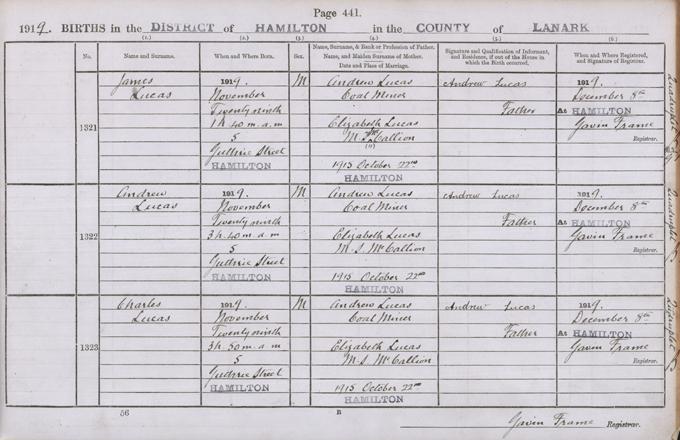Scotland's People has released 129,445 online images consisting of just over 207,000 births, deaths and marriage entries. You can search for, view and save images of all of them on the Scotland's People website. The newly available records include 37,111 marriages in 1944 and 63,821 deaths in 1969.
In this article we look at one family who registered four of the 106,268 Scottish births in 1919, which are now available to view online.
The Spanish Flu pandemic that had plagued not only Scotland but the whole world drew to a close in 1919, following the peace that had returned with the end of the First World War in November 1918. As a result, the national birth rate in the latter part of 1919 rose not only up to pre-war levels, but higher; October, for example, produced a birth rate of 27.1 per thousand – 8% over the pre-war average. By December this had risen to 21% above average.
By the end of 1919, the total population of Scotland was just under 4,900,000. Despite a relatively high birth rate, the number of births in 1919 was still around 20% lower than the highest number of births registered in Scotland in one year - 133,525 in 1908. In 1919, 54,771 of the registered births were male (an increase of 4,398 on the previous year) and 51,497 were female (an increase of 3,316).
For the first time in over ten years, The Registrar General’s report recorded that 1919 had witnessed the birth of quadruplets ‘all four alive at birth’. It went on to note that ‘This is the fifth time such an event has been registered since 1855’ (the dates being 1857, 1867, 1903, 1907 and 1919).
The proud parents of the quadruplets were Andrew and Elizabeth Lucas who lived at 5 Guthrie Street, Hamilton. Elizabeth was 28 years old when the quadruplets were born, and was a native of Londonderry. Andrew, 27 years old, was a coal miner. The couple already had two children – a three year old daughter Annie and 21 month old son John. The new arrivals, three boys and one girl, were born on 29th November 1919. Mary arrived first, followed by James, Andrew and Charles. The British Medical Journal reported that ‘the heaviest of the babies weighed about 2495g [2.49kg or 5.5lbs] and all three others around 2270g [2.27kg or 5lbs].’

The birth entries of James, Andrew and Charles Lucas, 29th November 1919.
Crown copyright, National Records of Scotland (NRS), Statutory Register of Births, 1919, 647/1322 page 441.

Image of the birth of Mary Lucas, 29th November 1919. The word 'quadruplet' has been written beside the entry.
Crown copyright, NRS, Statutory Register of Births, 1919, 647/1320 page 440.
The local press interviewed Andrew Lucas senior and reported that he was ‘most grateful for the kind attention from his neighbours’ who had been helping by taking turns to bottle feed the babies. Gifts of clothing and money had been sent from across Scotland and England.
Newspapers also reported that Andrew ‘remarked jocularly that the miners would not have to have many strikes in the future, otherwise he would be in “a bonnie pickle”.’ It was also noted that the Town Council of Hamilton would be arranging for the Lucas family to have a preferential claim on the first completed house in the new housing scheme that was under construction.
News of the excitement surrounding the birth reached senior members of the local area. A cheque for £10 from Lord Newlands was sent through the Lord Provost Keith of Hamilton. The Lord Lieutenant of the County of Lanark and Mrs Keith, the wife of the Lord Provost, had also gifted a cot for the children.
Unfortunately joy turned to tragedy as three of the children did not survive their first month. Just ten days old, James died at home on 9th December. His cause of death was noted as ‘birth debility. Abscess of lip two days.’ His brother Charles died two days later from ‘birth debility’ and was followed two days later by his sister Mary from the same cause.
Andrew, the only surviving quadruplet, became a merchant seaman. He died in Glasgow in 1980.
In the modern day, quadruplets are still rare, but are usually all born alive. The vast majority of these babies survive infancy and grow up to become healthy adults. The latest quadruplets to be born in Scotland were born in 2017.